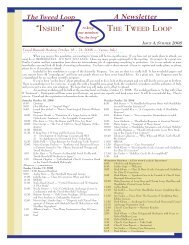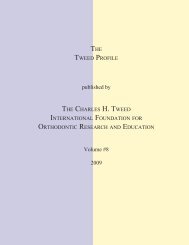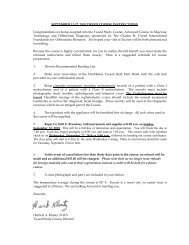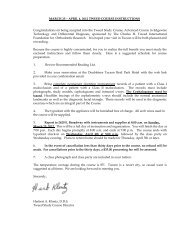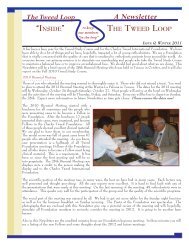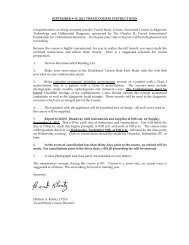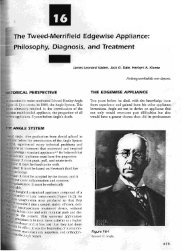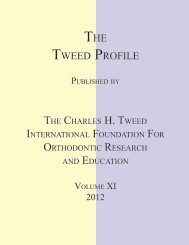the tweed profile - The Charles H. Tweed International Foundation
the tweed profile - The Charles H. Tweed International Foundation
the tweed profile - The Charles H. Tweed International Foundation
Create successful ePaper yourself
Turn your PDF publications into a flip-book with our unique Google optimized e-Paper software.
SIMPLIFIED TAD MECHANICS FOR MOLAR UPRIGHTING<br />
NICOLA DERTON<br />
CONEGLIANO, ITALY<br />
INTRODUCTION<br />
Prepros<strong>the</strong>tic orthodontic treatment plays a fundamental<br />
role for adult malocclusion correction. Mandibular molar<br />
uprighting is a huge help to both <strong>the</strong> surgeon and <strong>the</strong> prosthodontist<br />
because it creates ideal conditions for pros<strong>the</strong>tic<br />
rehabilitation of edentulous areas. Conventional orthodontic<br />
appliances, when used traditionally, can present some<br />
problems that are detrimental to <strong>the</strong> malocclusion correction.<br />
<strong>The</strong>se problems can include: molar extrusion, undesirable<br />
movements of an anchorage unit, a need for extended appliance<br />
wear, <strong>the</strong> need for auxiliary devices and/or a long treatment<br />
time. During <strong>the</strong> last several years, skeletal anchorage<br />
miniscrews have proved to be a reliable, efficient, and simple<br />
adjunct to any biomechanical system. <strong>The</strong> aim of this paper<br />
is to illustrate, by means of a case report, <strong>the</strong> guidelines for a<br />
simplified TAD approach to molar uprighting for pros<strong>the</strong>tic<br />
rehabilitation prior to restoration.<br />
CASE REPORT<br />
An adult woman presented with a Class I malocclusion and<br />
several missing teeth. (Figs. 1, 2, 3) <strong>The</strong> mandibular right<br />
second molar exhibited mesial inclination. After consultation<br />
with <strong>the</strong> prosthodontist, <strong>the</strong> plan that was developed was<br />
to insert two implants in <strong>the</strong> mandibular left quadrant and<br />
one implant in <strong>the</strong> mandibular right quadrant. Prior to implant<br />
insertion in <strong>the</strong> mandibular right quadrant, <strong>the</strong> mesioangular<br />
inclination of <strong>the</strong> mandibular right second molar had to<br />
be corrected. (Figs. 4, 5) Because of insufficient bony support,<br />
<strong>the</strong> orthodontic treatment plan called for TAD anchorage<br />
in order to simplify <strong>the</strong> mechanics. To accomplish molar<br />
uprighting, a 1.5 mm x 9 mm miniscrew (Spider C2HDC,<br />
Fig. 3<br />
Fig. 4 Fig. 5<br />
Sarcedo Italy) was inserted distal to <strong>the</strong> mandibular second<br />
molar and a metal button was bonded to <strong>the</strong> mesial surface<br />
of <strong>the</strong> molar. <strong>The</strong> force from <strong>the</strong> TAD to <strong>the</strong> inclined tooth<br />
was accomplished with an alastic chain. (Figs. 6, 7) To<br />
enhance <strong>the</strong> stability of <strong>the</strong> TAD, it was inserted in an outer<br />
oblique line to <strong>the</strong> retromolar area where thicker cortical<br />
bone can be easily found. <strong>The</strong> TAD was screwed deep into<br />
<strong>the</strong> bone in order to develop a vertical force vector system<br />
that would result in an intrusive effect on <strong>the</strong> molar. (<strong>The</strong><br />
head of <strong>the</strong> TAD was more cervical than <strong>the</strong> application<br />
point on <strong>the</strong> tooth.)<br />
Fig. 6 Fig. 7<br />
Fig. 1 Fig. 2<br />
34



